|
TennisOne Lessons Tennis without a pro?… No. Jerôme Inen 'There are 4 million pages on the internet with instruction how to hit a forehand. And that's just the forehand. Does all that information imply you don't need a pro to learn tennis any more? No, unless…
Here’s a little experiment I want you to do. Take three balls. Put one on the floor. One on a tabletop. One on a bookshelf, a little higher than your head. Now take a little distance, and run towards the respective balls to grab them. But stop! At the moment you touch the ball, freeze your movement. What will you see? When you grab the ball on the floor, you will be standings completely sideways, your hand pointing down, your lead foot and the ball pointing forward, the other foot in a straight line behind the front foot. When you grab the ball on the table, you will roughly be standing at an angle of 45 degrees towards the table, the palm of the grabbing hand will be facing forwards, the opposite foot slightly in front, the other foot at an angle positioned towards the lead foot. When you grab the ball on the bookshelf, you will be standing with your belly towards the shelves, the palm of your hand will point up, the foot on the side of the grabbing hand will be slightly forward, the other foot a little behind, but on the same line. So what does this all mean? Well, keep this little exercise in mind, the next time you google: ‘How to hit a forehand,’ combined with the keyword ‘tennis. You get more than 4 million pages of results. Just imagine. Four million pages of instruction on how to hit a forehand. And that’s just one stroke. There are millions of other pages, most for free, about every aspect of the game, whether technical — the serve, the volley, the backhand — or tactical. You can also find thousands and thousands of real time and slow-motion videos of the strokes of all the top-players, so you can study and try to copy their motions inch for inch. My answer is: Tennis without a pro? No. Unless… Why? Because though there may be a ton of information out there on the internet, there may be very little education about tennis on the internet. Why do I say that? Have I read all those millions of words of free instruction? No, I don’t have to. On Google you can do an advanced search, and then ask the search-machine to exclude results that don’t contain a word of choice. I did that. I asked Google to exclude all pages about hitting a tennis forehand that did not contain the word ‘bounce.’ The result was: 3,5 million pages about the hitting of the forehand did not mention the bounce of the ball. Why is that significant? Let’s get back to the bouncing-ball experiment we just did before. As you probably have felt, grabbing a ball at a certain height is the same as grabbing the racket to hit a ball at a certain height. The way you hold your racket, the way your torso is turned (or not), the way the feet are positioned are all determined by what I call the first factor of tennis: the bounce of the ball. That’s why talk about the lack of education about tennis on the internet. There are a lot of coaches there (and in the real world, I might add) who keep talking about ‘the modern forehand’. They make it sound as if a short time ago, a group of revolutionary teachers said: ‘Hey, we found this whole new way to hit a tennis ball. Everybody’s doing it wrong!’ Well, in my view it is ludicrous to teach someone a certain technique without explaining when and why to execute this technique and in what situation. If you take Rafael Nadal, here, hitting his famous full western-grip forehand… As you can see he standing with his torso turned forward, his hand grabs his racket with the palm up. He hits the ball at shoulder height. It would be impossible for him to hit the shot with the same technique if you ball would bounce at a height under his knee.
Bill Tilden dominated the tennis world in the 1920s at a time when tennis was primarily played on true grass, a surface on which the ball barely bounced (see photos below). As you can see he uses the ‘pick up ball from the ground’-technique performed in the video above. Tilden again, on another surface, hence a different ball height. Notice how his body is sideways to the ball. His left foot in a moment will step forward. The grip on the racket is an eastern forehand-grip, so the palm faces forward. So you see: Tilden did not need to ‘invent’ tennis (as many of his contemporaries believed, by the way), the movements of his body were predetermined by the bounce of the ball!
What happened between then and modern times, is not that tennis players suddenly invented new techniques for new times. First of all the, surfaces changed, balls starting to bounce higher and higher. Modern rackets meant players could hit balls with more topspin and higher, and still keep the ball in court. And another development, which is seriously underestimated: players started to learn tennis at a much younger age. When you are young, you are smaller. So a bounce of a ball that is waist-high for an adult, is head-high for a 9 year-old. And, as we’ve seen, such a high bounce means an open stance, a grip on the racket with the palm directed upwards. And when you use that technique you probably are going to hit the ball higher to your opponent. Who, on his turn will… well you get the idea. With this extensive example, I have started to explain why I say: Tennis without a pro, no, unless…’ You can learn tennis without a pro, but you need not only know what to do on the tennis court, but also understand why you are doing these things. True knowledge is more than information. Almost everyone knows the formula E=mc2. But how many people understand it, really? (I don’t!) So, if you want to learn tennis all on your own, or improve the effectiveness of your lessons, here are my key points to understanding the game. Understand the laws of the bounce — I've already shown that the bounce of the ball determines the position of the feet, the place of contact between racket and ball, the way you hold your racket, the motion your arm makes, and the swing path. But I have to add something, a ball doesn't only bounce upward, it also bounces towards you. Which means that your position on the court is also determined by the bounce of the ball. You probably heard as many times as I have, the quote: "I play best when I play with my teaching pro." Well, that is because your typical pro teaches you to stand exactly three feet behind the baseline, and then proceeds to hit balls to you that bounce at a comfortable height, around waist high. Which gives you the idea, "Gee, my strokes are really coming into their own right?"
The problem is that most players aren’t as skilled as your pro… and even if they were, opponents are not trying to feed you the perfect ball to hit. In fact, they are trying to do just the opposite. Because the height of their shots will be much higher (or lower over the net), the strokes that worked so well during your lesson may very well fall apart.
So understand, with tennis you have two choices.
Which brings me to the second key point: Technique is situation-bound and person-bound — Modern players are very fortunate that there is so much information about tennis technique nowadays. However, you should not fall in the trap of thinking there is an ideal technique. The form Federer uses to hit a perfect forehand of a ball that bounces at shoulder height, is not workable for a bounce that is about waist high. And vice-versa. Furthermore, if you are copying the strokes of Federer or another player, are you of the same height? Are you of the same weight? Do your arms, legs, and torso share the same proportions? Do you and Federer share the same flexibility of joints? Are you as quick as he is? Are you able to take the ball as early as he is after the bounce? If not (and I'm fairly certain that’s not the case), you should learn how to adapt your technique to your level, your physical proportions, and your age.
Be a professional learner — This is the last, and perhaps most difficult part of learning tennis without a pro — or learning any skill without a teacher for that matter.. Almost all of the tennis instruction at hand elaborate on ‘what are the best players doing, and how do they do it,, as if the details of their physical actions are all revealing. Much more important is why are they doing what they are doing? Why does the arm in the ‘modern’ forehand make a movement like a windshield wiper? It's not because that is the modern, best way to do it… but because for an incoming ball that is bouncing chest height and which you want to lift about six feet over the net, this arm movement is the most efficient. So you have to know a lot about the laws of physical movement to understand tennis. But that is not the only thing to being a professional learner. It is also an attitude. If there is one difficult thing about being a teaching pro, is that students just want to learn the trick. They want me to tell them: ‘Please tell me exactly how to do it and I will repeat that.’ They don’t want to hear about ‘why is it so,’ because it is more about wisdom than about straight out solutions. And that makes them nervous. But in tennis — like in playing piano, golf, or ballet — there is no trick. You have to explore your body in relationship to a little devil — a bouncing ball. If you want to learn tennis without a coach, you have to think for yourself and be professional about learning. Learning is a job; it’s a process in which you have to be critical about yourself. You should seek no excuses (it was the wind, my arm hurt) for losses or missed shots. You shouldn’t fall into the trap of assigning double faults to ‘mental problems.’ And then, just maybe, perhaps with the help of some equally dedicated friends, you could learn to play tennis without a pro.
Your comments are welcome. Let us know what you think about Jerôme Inen's article by emailing us here at TennisOne.
"I’ve learned tennis the traditional, form-oriented way — and it is not the right way! Lijftennis is my attempt to show other people a way to learn quicker, with better results and less frustration. If I have one message: don’t copy others, play and learn from your own body and perspective!" |
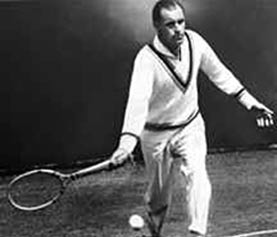
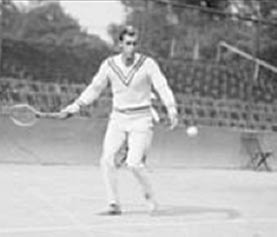
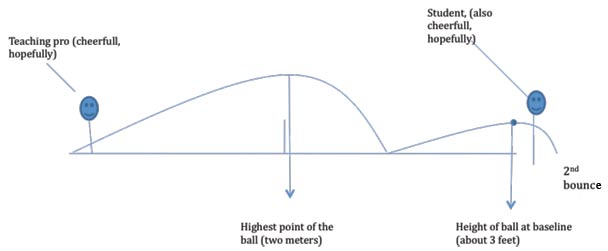
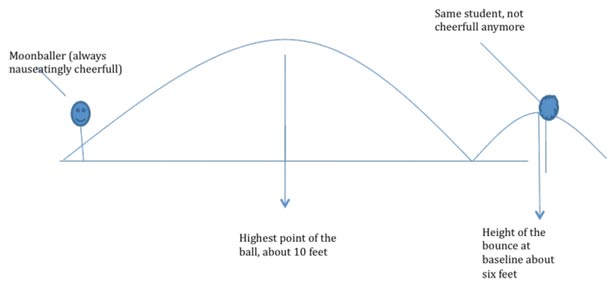
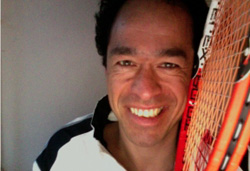 Jerôme Inen of
Jerôme Inen of